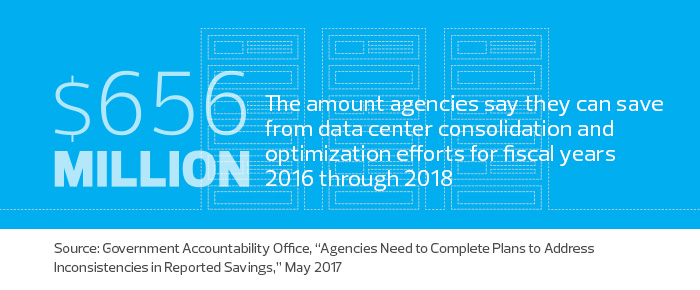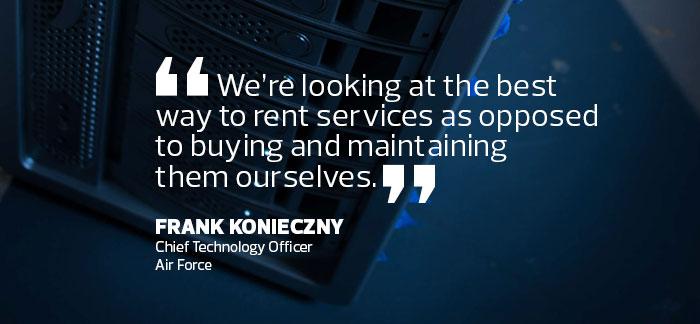What Is the Future of IT Purchasing? Less Hardware, More Services
Just months after joining the Small Business Administration, the agency’s new CIO and deputy CIO decided to eliminate their data center and move operations to the cloud.
An even more ambitious plan followed: “Our goal is not to buy any more hardware,” says Guy Cavallo, the agency’s deputy CIO.
Many CIOs now subscribe to the counter-intuitive philosophy of owning fewer IT possessions. Reaching that goal means consolidating data centers, virtualizing more servers, adopting cloud services or migrating to shared services. In short: buying less.
“Across the board, we’re looking at the best way to rent services as opposed to buying and maintaining them ourselves,” says Frank Konieczny, the Air Force’s chief technology officer.
Agencies such as the Defense Logistics Agency and National Institutes of Health are following a similar path.
This drive toward cloud adoption began with the so-called “Cloud First” policy issued by the Office of Management and Budget in 2010. Last year’s Data Center Optimization Initiative — calling for agencies to meet new energy efficiency and cost reduction goals — reinforced those efforts.
Initiatives geared toward the cloud and data center consolidation are expected to remain a priority throughout the Trump administration, says Shawn McCarthy, research director at IDC Government Insights. That’s because the White House is interested in technologies that lead to cost savings, improved security, faster implementations and standardization.
“It’s clear that cloud growth will continue to increase in the years ahead,” he says. “Cloud-based systems have proven to be a reliable and cost- effective alternative to owning your own infrastructure.”
Migrate Data Centers to the Cloud
In February, Cavallo and SBA CIO Maria Roat began migrating applications to Microsoft Azure’s Infrastructure as a Service (IaaS) offering. They expect to move most, if not all, of the agency’s data center operations to the cloud within a year.
“When we assessed our environment and found obsolete and failing technology that would cost millions of dollars to replace, we decided to go all in on the cloud,” Cavallo says.

The pair inherited a data center with plenty of outdated servers and software as well as a checkered history that included two outages caused by flooding and clogged air conditioning drains.
While IT teams were migrating on-premises email and SharePoint applications to Microsoft’s Office 365 Software as a Service (SaaS) cloud, SBA’s leadership made plans to migrate the remaining on-premises applications to Microsoft Azure’s infrastructure cloud service.
In the future, the SBA expects to adopt more SaaS offerings and build new applications using Platform as a Service (PaaS).
Shut Down Legacy Systems to Save Money
In preparing for the transformation, SBA staff and cloud consultants decommissioned older servers and moved virtual machines to newer servers. In doing so, they eliminated 180 physical servers. About 200 remain.
Cavallo hopes to complete the cloud migration project within fiscal 2018. Instead of just lifting and shifting the applications to the cloud, the agency is updating the applications to the most current versions and installing the latest patches before moving them to Azure. In some cases, the agency doesn’t want to migrate legacy software, so staff is rewriting those applications.
“Every day we shut down something physical on-premises and get it to the cloud,” he says.
While Cavallo doesn’t want to purchase servers or storage hardware anymore, SBA will always have a certain amount of hardware, including networking equipment, personal computers and tablets, so users can connect to the cloud and complete their work.
“The most important thing is uptime, redundancy and cost savings, which can now be reinvested in the SBA’s core mission of supporting and building small businesses,” he says. “We won’t have to go to our CFO and say, ‘Give me $6 million every three to five years because I need to buy a new data center.’ That’s big savings.”
The Air Force Learns from Cloud Pilots
The Air Force is following a similar flight path. The service’s leaders want to shift commodity IT services to the cloud and eliminate their Exchange servers.
Two years ago, Air Force officials partnered with the Defense Logistics Agency (DLA) and inked a contract with Microsoft and other vendors to build a custom version of Office 365 that meets the stringent security requirements of the Defense Department.
The Air Force replaced in-house email with Office 365 across bases worldwide. “We had some rough starts, but we are now chugging along nicely,” Konieczny says. Now, the service is waiting for DOD to finalize plans to select a commercial provider for a new email solution. It will standardize on whatever DOD chooses.
The Air Force also launched a new version of its personnel application in the commercial cloud. Now, users can fill out online forms and receive information on benefits in a SaaS environment that requires less hardware. Finally, the service is piloting a hybrid cloud for records management, a project that will feature searchable data and running analytics, Konieczny says.
Cloud Adoption Enables Faster Research
Such wide-scale transitions don’t happen overnight. Alastair Thomson, CIO of the National Heart, Lung, and Blood Institute, part of NIH, was initially a cloud skeptic. But nearly five years ago, he moved the agency’s website to the cloud. The change reduced the site’s maintenance costs by 80 percent, and it allowed the agency to handle traffic spikes during research announcements.
He was sold. Since then, Thomson has consolidated his data centers from seven to three. The remaining IT infrastructure is critical: a primary site, a disaster-recovery site, and a third that houses patient care systems and data that must remain in-house for security reasons, he says.

Now, his team is focusing on moving administrative apps to the cloud. The IT staff is rewriting some legacy client-server apps — including tools for grants management and budget tracking — in a PaaS environment. The team is also moving a custom-built performance management system to the cloud for adoption throughout the NIH and the Food and Drug Administration.
Most recently, the agency started exploring the impact the cloud could have on research. About 4 percent of the agency’s research takes place in the cloud, but Thomson expects that percentage to rise. The institute ran four pilots that used high-performance computing in the cloud, and the early results are promising. One staffer, for example, used HPC and completed more research in six weeks than she previously could in six months.
“That’s an incredible acceleration,” Thomson says.
Cloud Helps Agencies Avoid Managing Infrastructure
For DLA, which provides logistics support for military services worldwide, less infrastructure means moving applications from agency data centers to the Defense Information Systems Agency’s (DISA’s) milCloud infrastructure cloud service, which has hosted DLA’s core business systems for years.
But it also marks a return to the agency’s core mission.
“We want to get to a point where we’re managing the provider and consuming the services so we can focus on our primary mission — logistics,” says DLA Chief Technology Officer Bruce Paton. “We don’t want to own our infrastructure or manage it.”
DLA recently migrated its 27,000 users to Office 365 for email and collaboration, and the agency is exploring commercial cloud providers that may offer more advanced capabilities, he says.
“Our priority is Software as a Service wherever possible,” he says.
At its peak, the agency had nearly 30 data centers but aims to shrink that number to two. Next, the agency will remove the customization from much of its off-the-shelf software, then remove that software from DISA’s data centers and subscribe users to SaaS offerings instead. This process could take as long as seven years, but Paton sees the cloud as the best path forward.
“We are in an era of fiscal austerity, but it goes beyond that to capability,” he says. “The cloud is really the way industry is going and where innovation is happening.”









